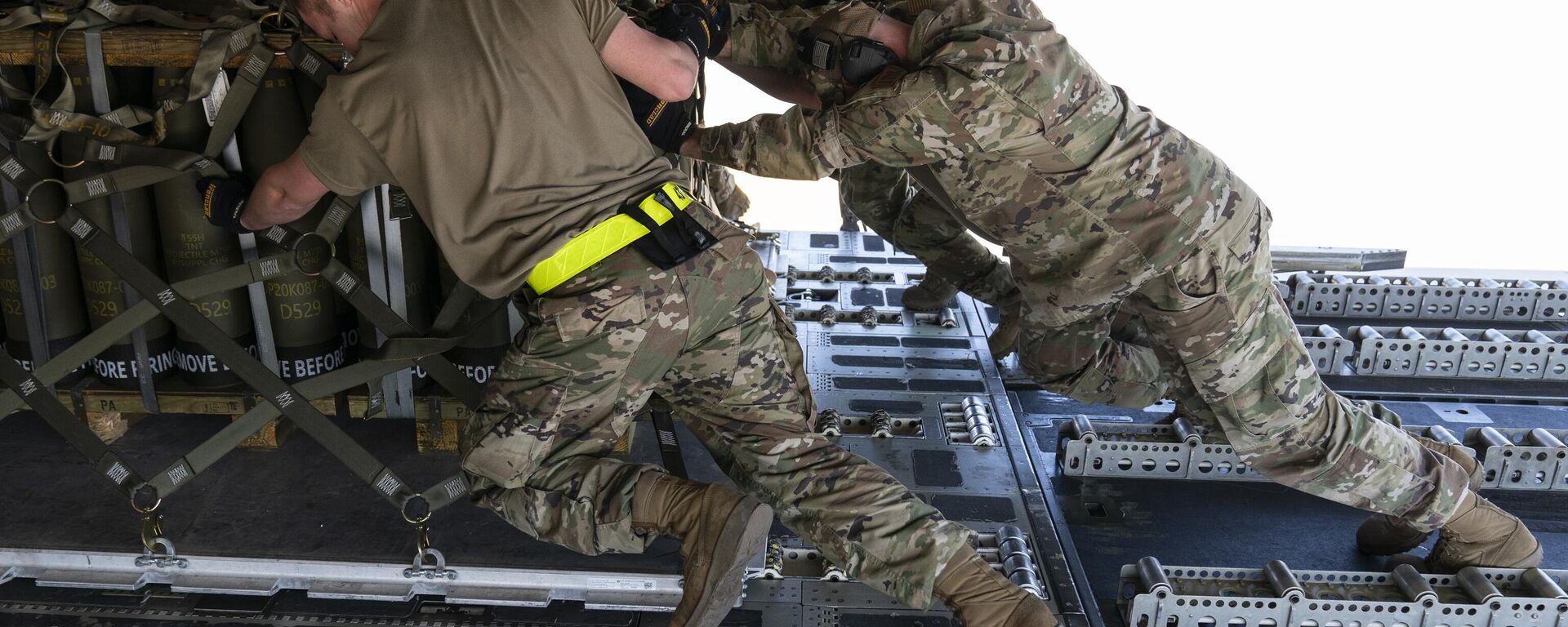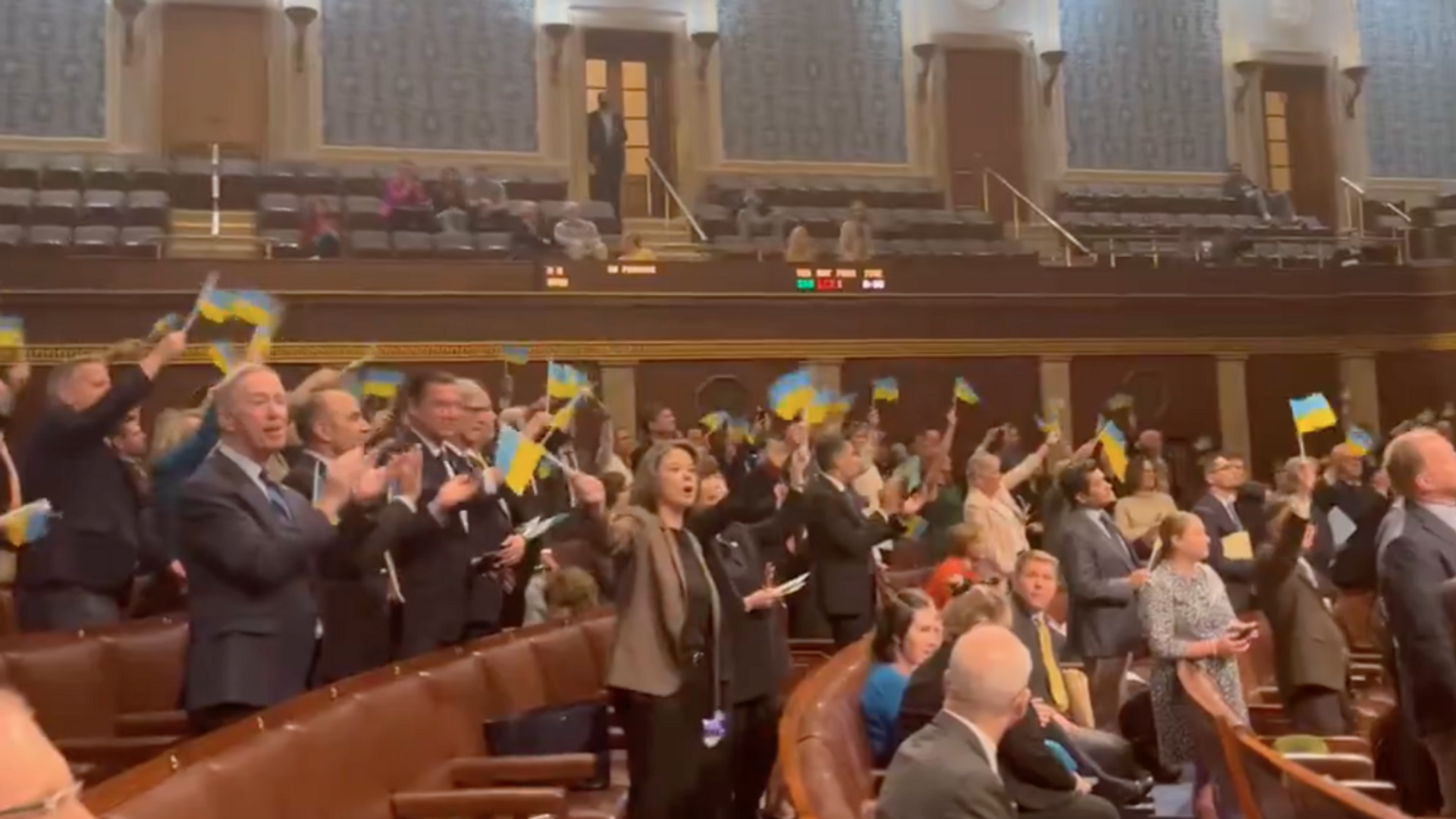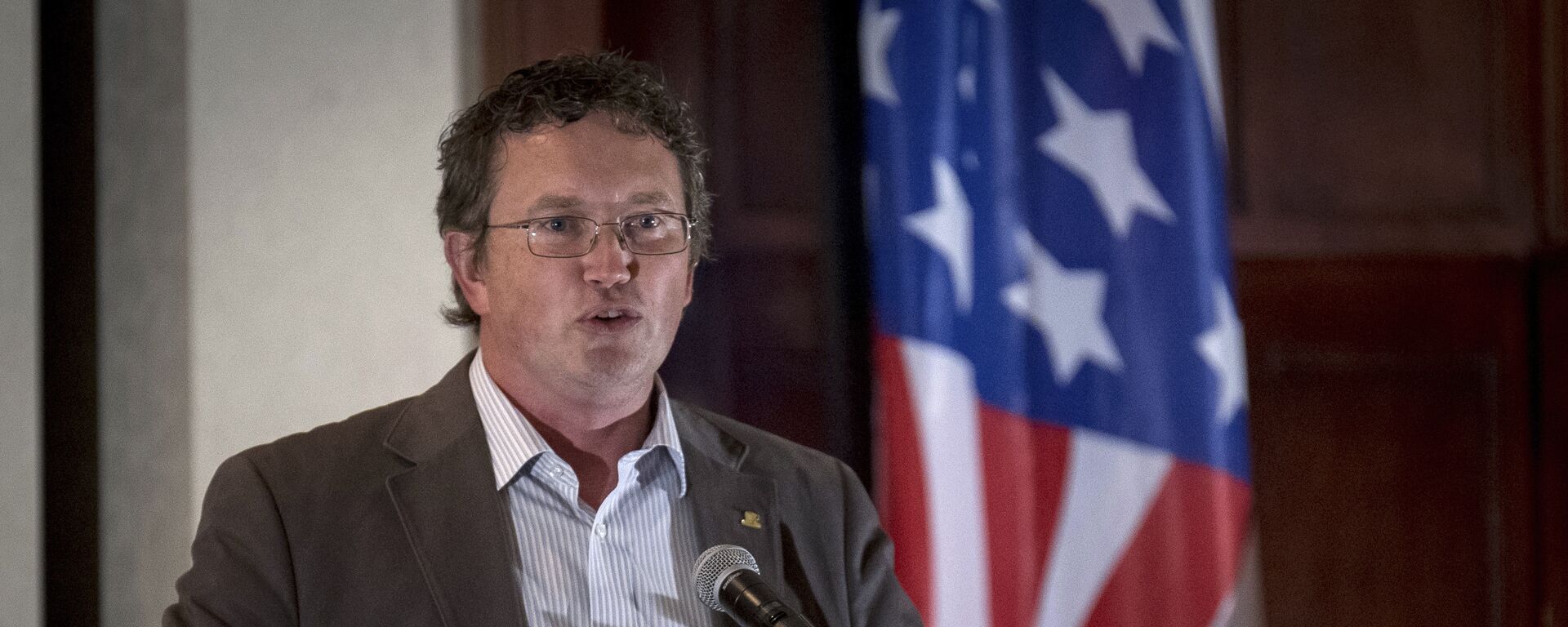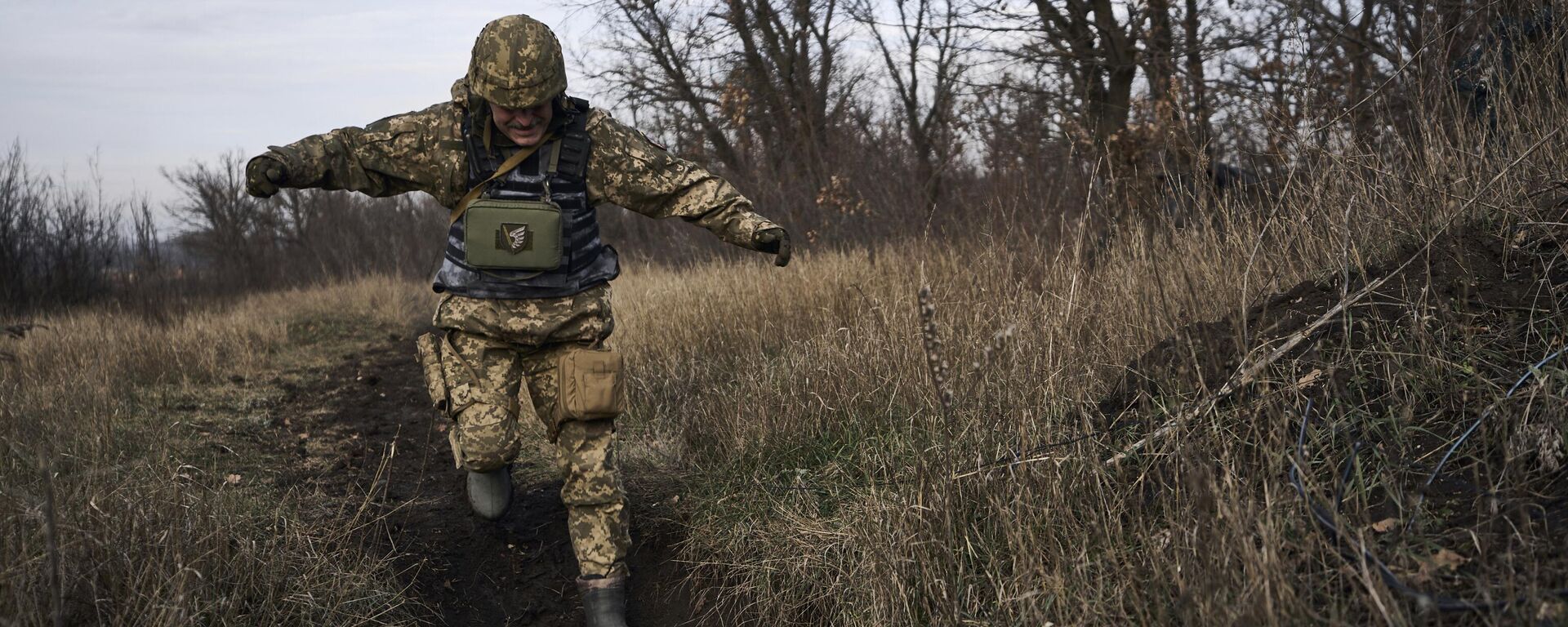https://sputnikglobe.com/20240424/us-congress-votes-for-weapons-free-healthcare-for-ukraine-1118099981.html
US Congress Votes for Weapons, Free Healthcare for Ukraine
US Congress Votes for Weapons, Free Healthcare for Ukraine
Sputnik International
US lawmakers gathered over the weekend to pass funding for Ukraine, Israel and anti-China authorities in Taiwan.
2024-04-24T23:42+0000
2024-04-24T23:42+0000
2024-04-25T00:08+0000
ukraine
mark sleboda
volodymyr zelensky
joe biden
russia
fault lines
army tactical missile system (atacms)
us arms for ukraine
nato
us
https://cdn1.img.sputnikglobe.com/img/07e8/04/18/1118100457_6:0:1266:709_1920x0_80_0_0_8f7778a8f294ccc889a7eb74c409d617.png
After months of languishing in congressional purgatory, Washington lawmakers finally passed renewed spending for Ukraine’s proxy war against Russia over the weekend.The aid package, worth some $61 billion, moved forward with the support of about half of congressional Republicans and the majority of Democrats. Its passage prompted a dramatic display of patriotic pride – but not for the United States. A sea of Ukrainian flags was observed as representatives waved miniature versions of the blue and yellow banner. The scene prompted criticism from some Republicans, who questioned the legality of the display of a foreign flag in the legislative chamber.International relations expert Mark Sleboda joined Sputnik’s Fault Lines program Wednesday to discuss the development and its implications for Kiev’s struggling war effort.“So first of all, on the surface, $61 billion – read into the details. That's the first thing,” said the security analyst. “You'll see that of that, only $14 billion is direct military aid to the Kiev regime in Ukraine. Actually, the largest chunk of that is $20 billion worth that is supposedly going to restock US military inventories because the Biden administration cut too deep into the US military's own supplies already in order to provide the Kiev regime.”“Of course there's nothing stopping them from using that drawdown authority again if it becomes necessary,” he noted. “Some $8 billion is going towards training and the like.”But, perhaps most controversially, a significant portion of the aid will go towards simply maintaining the functioning of Ukrainian civil society – a contentious prospect as the country is frequently ranked Europe’s most corrupt.“$8 billion is going to support the Ukrainian budget, of course, because it is entirely dependent on Western aid,” said Sleboda. “Some of that is also coming from the EU, by the way. So they'll be paying for peoples' salaries and health care for Ukrainians because actually Ukraine has a government health care system.”A majority of Americans polled have consistently supported some form of guaranteed health insurance for all citizens, although industry lobbying efforts have so far scuttled all attempts to implement such a system.The sending of increasingly more powerful weapons to Kiev has led to concerns its military will continue to attack non-combatant civilians in territory controlled by Russia. Ukraine has frequently launched strikes on non-military targets in Crimea and the Bakhmut region.Ukraine’s attacks on civilians have gone largely unreported in Western media although the country has faced intense criticism for its massacres in the Donbass region going back to 2014. In one particularly shocking incident neo-Nazi paramilitaries attacked a peaceful rally of trade unionists in Odessa, setting first to a union hall after civilians sought refuge there.“The long range strategy that they're looking at is they need to bring the war home to the Russian people,” claimed Sleboda. “They need to challenge the political stability in Russia to make Russian people turn against the conflict, which they admit, essentially, that the Russian people are fully behind the government in this.”“You have to shatter the psyche and the morale of the Russian people. This was always the goal, they just failed to do it with sanctions. Utterly failed to do it.”Sleboda enumerated the armaments the Kiev regime would likely utilize to meet its goal: “These are NATO weapons, particularly US weapons. We're talking here with the ATACMS, more Storm Shadows have also been sent from the UK, and they are guided to target by NATO satellites and reconnaissance planes. That's how the targeting is done. So this is a NATO attack.”Meanwhile Ukrainian President Volodymyr Zelensky’s rule appears as uncertain as ever as a lack of morale and discipline within the military persists.“There's political turmoil in Kiev as well because Zelensky's term ends on May 21st, right around the time the Russian offensive is supposed to start,” said Sleboda. “The far-right is furious at him because he just banned the 67th [division] after they refused his orders, which is the Right Sector. And also the third assault Azov has been refusing orders to go into places like Chasov Yar.”“We've had multiple Ukrainian brigades just disobey orders at this point because they're not going into Ocheretino, right? No one wants to go. There's certain areas that are described as hell. And they don't want to go into conditions like that… We're starting to see people not willing to die.”
https://sputnikglobe.com/20240423/us-congressman-says-facing-500-fine-for-sharing-video-of-lawmakers-waving-ukrainian-flag-1118082014.html
https://sputnikglobe.com/20240224/pentagon-probing-over-50-cases-of-theft-fraud-or-corruption-linked-to-ukraine-aid-1116953199.html
https://sputnikglobe.com/20240418/russias-role-in-global-trade-grows-despite-western-sanctions-1117996562.html
https://sputnikglobe.com/20240413/new-order-from-ukraines-top-general-reveals-scale-of-sabotage-and-desertion-in-army-1117906138.html
ukraine
russia
Sputnik International
feedback@sputniknews.com
+74956456601
MIA „Rossiya Segodnya“
2024
John Miles
https://cdn1.img.sputnikglobe.com/img/07e8/01/19/1116388787_0:0:1316:1316_100x100_80_0_0_77e70d36afd983012b1c5d38ddb84156.jpg
John Miles
https://cdn1.img.sputnikglobe.com/img/07e8/01/19/1116388787_0:0:1316:1316_100x100_80_0_0_77e70d36afd983012b1c5d38ddb84156.jpg
News
en_EN
Sputnik International
feedback@sputniknews.com
+74956456601
MIA „Rossiya Segodnya“
Sputnik International
feedback@sputniknews.com
+74956456601
MIA „Rossiya Segodnya“
John Miles
https://cdn1.img.sputnikglobe.com/img/07e8/01/19/1116388787_0:0:1316:1316_100x100_80_0_0_77e70d36afd983012b1c5d38ddb84156.jpg
us supports ukraine, us fuds ukraine, funding to ukraine, more money to ukraine, ukrainian crisis, crisis in ukraine, us hegemony
us supports ukraine, us fuds ukraine, funding to ukraine, more money to ukraine, ukrainian crisis, crisis in ukraine, us hegemony
US Congress Votes for Weapons, Free Healthcare for Ukraine
23:42 GMT 24.04.2024 (Updated: 00:08 GMT 25.04.2024) US lawmakers gathered over the weekend to pass funding for Ukraine, Israel and anti-China authorities in Taiwan.
After months of languishing in congressional purgatory, Washington lawmakers finally passed renewed spending for Ukraine’s proxy war against Russia over the weekend.
The aid package, worth some $61 billion, moved forward with the support of about half of congressional Republicans and the majority of Democrats. Its passage prompted a dramatic display of patriotic pride – but not for the United States.
A sea of Ukrainian flags was observed as representatives waved miniature versions of the blue and yellow banner. The scene prompted criticism from some Republicans, who questioned the legality of the display of a foreign flag in the legislative chamber.
International relations expert Mark Sleboda joined
Sputnik’s Fault Lines program Wednesday to discuss the development and its implications for Kiev’s struggling war effort.
“So first of all, on the surface, $61 billion – read into the details. That's the first thing,” said the security analyst. “You'll see that of that, only $14 billion is direct military aid to the Kiev regime in Ukraine. Actually, the largest chunk of that is $20 billion worth that is supposedly going to restock US military inventories because the Biden administration cut too deep into the US military's own supplies already in order to provide the Kiev regime.”
“Of course there's nothing stopping them from using that drawdown authority again if it becomes necessary,” he noted. “Some $8 billion is going towards training and the like.”
But, perhaps most controversially, a significant portion of the aid will go towards simply maintaining the functioning of Ukrainian civil society – a contentious prospect as the country is
frequently ranked Europe’s most corrupt.
“$8 billion is going to support the Ukrainian budget, of course, because it is entirely dependent on Western aid,” said Sleboda. “Some of that is also coming from the EU, by the way. So they'll be paying for peoples' salaries and health care for Ukrainians because actually Ukraine has a government health care system.”
“Hey, American taxpayers, you can't get a health care system but the Kiev regime that you support in Ukraine thanks you for your hard-earned tax dollars for that, because that's part of the Ukrainian budget.”
A majority of Americans polled have consistently
supported some form of guaranteed health insurance for all citizens, although industry lobbying efforts have so far scuttled all attempts to implement such a system.

24 February 2024, 14:22 GMT
The sending of increasingly more powerful weapons to Kiev has led to concerns its military will continue to attack non-combatant civilians in territory controlled by Russia. Ukraine has frequently launched strikes on non-military targets in Crimea and the Bakhmut region.
Ukraine’s attacks on civilians have gone largely unreported in Western media although the country has faced intense criticism for its massacres in the Donbass region going back to 2014.
In one particularly shocking incident neo-Nazi paramilitaries attacked a peaceful rally of trade unionists in Odessa, setting first to a union hall after civilians sought refuge there.“The long range strategy that they're looking at is they need to bring the war home to the Russian people,” claimed Sleboda. “They need to challenge the political stability in Russia to make Russian people turn against the conflict, which they admit, essentially, that the Russian people are fully behind the government in this.”
“Which means long-range strikes, which means more acts… they don't say it outright, but making it clear, how do you bring the war home to the Russian people?” he asked. “You kill civilians. You do attacks that will affect the Russian people. Crocus City Hall, right? That sort of thing. The Crimean bridge, right? Big, symbolic, doesn't have any real military value as a target, as we've heard German generals attest to when they didn't think they were being listened to, as they plotted out how to attack it. But it's symbolic, right?”
“You have to shatter the psyche and the morale of the Russian people. This was always the goal, they just failed to do it with sanctions. Utterly failed to do it.”
Sleboda enumerated the armaments the Kiev regime would likely utilize to meet its goal: “These are NATO weapons, particularly US weapons. We're talking here with the ATACMS, more Storm Shadows have also been sent from the UK, and they are guided to target by NATO satellites and reconnaissance planes. That's how the targeting is done. So this is a NATO attack.”
Meanwhile Ukrainian President Volodymyr Zelensky’s rule appears as uncertain as ever as a lack of morale and discipline within the military persists.
“There's political turmoil in Kiev as well because Zelensky's term ends on May 21st, right around the time the Russian offensive is supposed to start,” said Sleboda. “The far-right is furious at him because he just banned the 67th [division] after they refused his orders, which is the Right Sector. And also the third assault Azov has been refusing orders to go into places like Chasov Yar.”
“We've had multiple Ukrainian brigades just disobey orders at this point because they're not going into Ocheretino, right? No one wants to go. There's certain areas that are described as hell. And they don't want to go into conditions like that… We're starting to see people not willing to die.”







